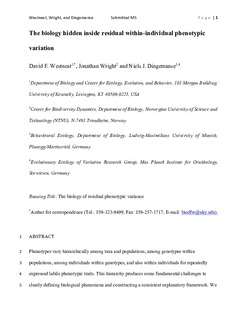| dc.description.abstract | Phenotypes vary hierarchically among taxa and populations, among genotypes within populations, among individuals within genotypes, and also within individuals for repeatedly expressed, labile phenotypic traits. This hierarchy produces some fundamental challenges to clearly defining biological phenomena and constructing a consistent explanatory framework. We use a heuristic statistical model to explore two consequences of this hierarchy. First, although the variation existing among individuals within populations has long been of interest to evolutionary biologists, within-individual variation has been much less emphasized. Within-individual variance occurs when labile phenotypes (behaviour, physiology, and sometimes morphology) exhibit phenotypic plasticity or deviate from a norm-of-reaction within the same individual. A statistical partitioning of phenotypic variance leads us to explore an array of ideas about residual within-individual variation. We use this approach to draw attention to additional processes that may influence within-individual phenotypic variance, including interactions among environmental factors, ecological effects on the fitness consequences of plasticity, and various types of adaptive variance. Second, our framework for investigating variation in phenotypic variance reveals that interactions between levels of the hierarchy form the preconditions for the evolution of all types of plasticity, and we extend this idea to the residual level within individuals, where both adaptive plasticity in residuals and canalization-like processes (stability) can evolve. With the statistical tools now available to examine heterogeneous residual variance, an array of novel questions linking phenotype to environment can be usefully addressed. | nb_NO |
